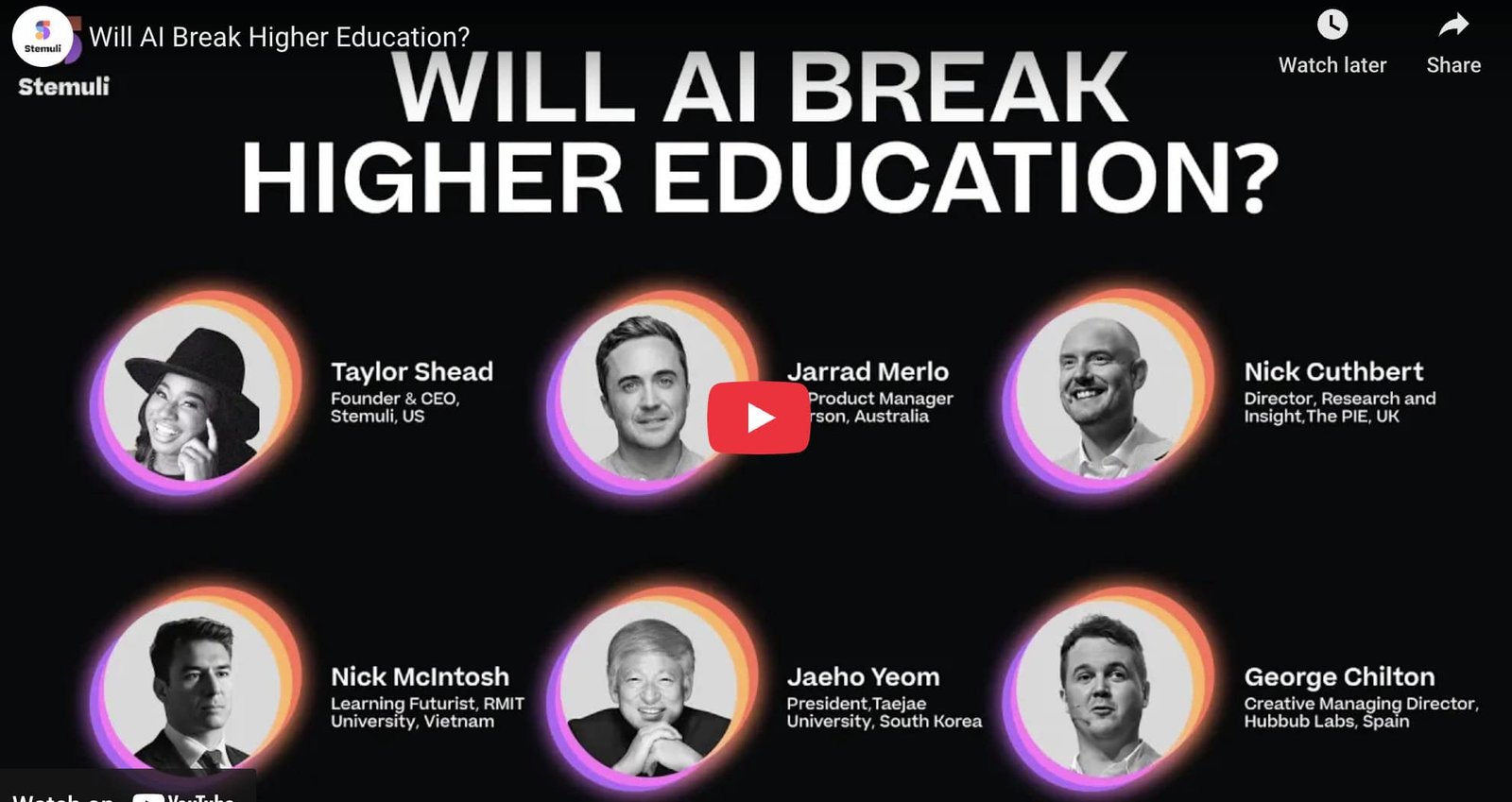Education
Will AI break higher education?

Education
NVIDIA Partners With Black Tech Street To Advance AI Education In Tulsa

Black Tech Street (BTS) is bringing transformative AI innovation education to Tulsa’s Historic Greenwood District with the help of microchip maker NVIDIA. The partnership aims to help Tulsa become a national model for tech-driven economic empowerment and community advancement.
NVIDIA, the world’s most valuable company, will collaborate with the organization to lead efforts in integrating cutting-edge technologies, according to The Black Wall Street Times.
“NVIDIA is powering the AI revolution—likely the most impactful leap in human history,” Tyrance Billingsley II, founder and CEO of Black Tech Street, said. “To have them standing with us in Greenwood, committing to help our community harness and lead this revolution, means more than I can articulate. This is a game-changing win for Black Wall Street.”
Advancing tech in Tulsa
As a member of Tulsa’s Tech Hub coalition (led by Tulsa Innovation Labs), Black Tech Street has played a significant role in the city’s designation as a Tech Hub for Autonomous Systems by the US Economic Development Administration.
The coalition recently secured $51 million in federal funding, with $10.6 million allocated to create a Greenwood AI Center of Excellence, led by Black Tech Street. Black Tech Street and NVIDIA will partner with the Tech Hub and local community organizations through this collaboration.
The State of Oklahoma will also be a part of this partnership, as it will train up to 10,000 learners. Training will be delivered through educational institutions and community partners.
Goals of the partnership
The partnership has three main goals: expanding AI education, boosting Tulsa’s economy, and positioning the city as a national hub for AI innovation. By offering advanced training programs through local institutions, the initiative will give Tulsa’s wider community access to in-demand AI skills. In turn, this will help create high-paying jobs and establish Tulsa—through Greenwood—as both a model and a testing ground for AI development.
NVIDIA will commit to the partnership by hiring local entrepreneurs, technologists, and students for NVIDIA’s training and certification programs. The company will also collaborate with Black Tech Street to secure federal, state, and philanthropic funding for research and talent development. Additionally, NVIDIA will connect Tulsa startups with its Inception program and global startup ecosystem to help accelerate local growth.
“This partnership will generate economic impact for years to come. NVIDIA and Black Tech Street are setting the stage for new jobs for Tulsans and opening doors of opportunity for our community,” Tulsa Mayor Monroe Nichols said.
Image: Mike Creef
Education
Education 5.0: AI and personalized learning drive the future of learning

The rapid rise of artificial intelligence (AI) and immersive digital tools is reshaping the foundations of modern education, demanding urgent strategic reform to prepare Generation Alpha for a technology-driven future.
Researchers have mapped this educational shift in a study titled “Education Strategy for the Net Generation”, published in Information. The paper calls for a complete overhaul of conventional teaching practices, outlining a new pedagogical model to align learning with the dynamic realities of the digital and generative AI eras.
The shift from digital to generative pedagogy
The research positions the evolution of education within a broad historical and technological framework, explaining how learning models must keep pace with societal and digital transformations. The authors describe how the transition from Web 2.0 to Web 4.0, combined with the rise of generative AI (GAI), large language models (LLMs), and immersive technologies like AR, VR, and IoT, has ushered education into a new era – Education 5.0.
Education 4.0, driven largely by digital pedagogy and the integration of online platforms, was sufficient for the early 21st century but no longer meets the needs of learners shaped by hyper-connectivity and intelligent systems. Generation Alpha, those born between 2010 and 2024, are fundamentally different from previous generations, acquiring information in complex, dynamic ways and demanding new teaching approaches that merge human intelligence with advanced technological tools. According to the authors, Education 5.0 is not just an incremental improvement; it represents a paradigm shift toward generative pedagogy, a hybrid system combining symbolic cognitive methods with AI-powered connectionist approaches.
This new framework emphasizes personalized learning paths, real-time feedback loops, and collaborative, interdisciplinary environments. Teachers, once positioned as transmitters of knowledge, must now act as mentors and interpreters, guiding students through the complexities of human–machine interaction. The model calls for cultivating not only cognitive skills but also emotional and ethical intelligence, ensuring that students remain critically aware and human-centered in a digital landscape increasingly mediated by AI.
Personalization, feedback, and collaboration in Education 5.0
Generative pedagogy harnesses the power of AI, machine learning, and big data to enhance the learning process. Adaptive platforms analyze student performance and behavior to create individualized learning experiences, ensuring that content delivery aligns with personal learning styles and needs. This hyper-personalization marks a significant departure from the one-size-fits-all approach that defined traditional education.
Real-time feedback has also emerged as a defining characteristic of Education 5.0. AI-powered systems, such as chatbots and smart tutors, are capable of instantly assessing student progress, providing immediate insights, and adjusting learning pathways in response to performance metrics. By integrating sensor technologies like eye-tracking and facial recognition, these systems can measure engagement and attention, offering educators actionable data to refine teaching methods and optimize outcomes.
Collaboration, a cornerstone of contemporary pedagogy, is also being transformed. The research highlights how digital platforms now enable interactive and collaborative learning spaces that transcend geographical barriers. These systems facilitate group discussions, joint projects, and peer-to-peer learning, fostering an environment where knowledge creation becomes a shared, participatory process. The integration of immersive technologies, such as extended reality and virtual environments, further supports active learning and deep engagement, ensuring students are not passive recipients of information but active co-creators of knowledge.
A case study within the research demonstrates how these concepts can be practically applied. In a vocational robotics program, students engaged in immersive digital classrooms that combined traditional teaching methods with VR-enhanced learning modules. The results were compelling: the experimental group outperformed the control group in task completion, demonstrated higher levels of motivation, and achieved better retention of complex concepts. This evidence reinforces the potential of generative pedagogy to enhance both technical proficiency and critical thinking in real-world educational settings.
Challenges, implications, and the road ahead
The study acknowledges significant resistance within educational institutions. Many educators remain skeptical, echoing earlier skepticism during the advent of digital tools, while others express concern over the reliability and ethical implications of AI systems. The rapid pace of technological evolution has also created a gap between industry capabilities and classroom realities, with schools often lagging behind in adopting and integrating cutting-edge innovations.
The authors argue that this resistance underscores the need for a balanced, critically informed approach to integrating AI into education. Generative AI, while powerful, is not infallible. It can produce errors, perpetuate biases, and generate misleading outputs, making critical engagement an essential component of modern learning. Students must be taught to treat AI as a partner rather than an unquestioned authority, applying rigorous sensemaking and analytical skills to every interaction.
The paper calls for redefining teachers’ roles in a hybrid human–machine learning environment. They will no longer be the sole arbiters of knowledge but will function as co-navigators, helping students critically navigate AI-mediated information ecosystems. This shift requires educators to adopt reflective practices and maintain a commitment to pedagogical integrity, ensuring that technology enhances rather than diminishes the human essence of education.
Education
Voice AI in Education Market Is Going to Boom

HTF MI just released the Global Voice AI in Education Market Study, a comprehensive analysis of the market that spans more than 143+ pages and describes the product and industry scope as well as the market prognosis and status for 2025-2032. The marketization process is being accelerated by the market study’s segmentation by important regions. The market is currently expanding its reach.
Major companies profiled in Voice AI in Education Market are: Google, Amazon (Alexa), Microsoft, IBM Watson, Nuance, Baidu, iFlytek, SoundHound, Sensory Inc, Smart Sparrow, Carnegie Learning, LinguaLeo, Speechace, Deepgram, ReadSpeaker, ELSA Speak, Sonantic, Soapbox Labs, Voiceitt, Sestek.
Request PDF Sample Copy of Report: (Including Full TOC, List of Tables & Figures, Chart): https://www.htfmarketinsights.com/sample-report/4377851-voice-ai-in-education-market?utm_source=Altab_OpenPR&utm_id=Altab
HTF Market Intelligence projects that the global Voice AI in Education market will expand at a compound annual growth rate (CAGR) of 26.5% from 2025 to 2033, from USD 1.2 Billion in 2025 to USD 7.9 Billion by 2033.
The following Key Segments Are Covered in Our Report
By Type
Voice-enabled tutoring, Language learning assistants, Smart classrooms, Speech-to-text systems, Interactive reading tools
By Application
Language learning, Accessibility for disabled, Virtual classrooms, Personalized tutoring, Test prep
Definition: Voice AI in education refers to the use of speech recognition and natural language processing (NLP) technologies to facilitate learning and communication between students and educational platforms. Voice AI enables interactive language learning, assists students with disabilities, automates administrative tasks, and supports personalized tutoring. With the rise of smart devices, conversational AI, and accessibility requirements, educational institutions are adopting voice-based solutions to make learning more inclusive and engaging.
Market Trends:
• Conversational AI in classrooms, Multilingual support, Gamified voice learning, Integration with LMS, Voice biometrics
Market Drivers:
• AI adoption in education, Rising need for personalized learning, Growth of voice-enabled devices, Inclusivity goals, EdTech boom
Market Challenges:
• Privacy concerns, Accent recognition issues, High development cost, Data security, Low adoption in rural schools
Dominating Region:
North America
Fastest-Growing Region:
Asia-Pacific
Buy Now Latest Edition of Voice AI in Education Market Report: https://www.htfmarketinsights.com/buy-now?format=1&report=4377851
The titled segments and sub-section of the market are illuminated below:
In-depth analysis of Voice AI in Education market segments by Types: Voice-enabled tutoring, Language learning assistants, Smart classrooms, Speech-to-text systems, Interactive reading tools
Detailed analysis of Voice AI in Education market segments by Applications: Language learning, Accessibility for disabled, Virtual classrooms, Personalized tutoring, Test prep
Geographically, the detailed analysis of consumption, revenue, market share, and growth rate of the following regions:
• The Middle East and Africa (South Africa, Saudi Arabia, UAE, Israel, Egypt, etc.)
• North America (United States, Mexico & Canada)
• South America (Brazil, Venezuela, Argentina, Ecuador, Peru, Colombia, etc.)
• Europe (Turkey, Spain, Turkey, Netherlands Denmark, Belgium, Switzerland, Germany, Russia UK, Italy, France, etc.)
• Asia-Pacific (Taiwan, Hong Kong, Singapore, Vietnam, China, Malaysia, Japan, Philippines, Korea, Thailand, India, Indonesia, and Australia).
Have different Market Scope & Business Objectives; Enquire for customized study: https://www.htfmarketinsights.com/report/4377851-voice-ai-in-education-market?utm_source=Altab_OpenPR&utm_id=Altab
Voice AI in Education Market Research Objectives:
– Focuses on the key manufacturers, to define, pronounce and examine the value, sales volume, market share, market competition landscape, SWOT analysis, and development plans in the next few years.
– To share comprehensive information about the key factors influencing the growth of the market (opportunities, drivers, growth potential, industry-specific challenges and risks).
– To analyze the with respect to individual future prospects, growth trends and their involvement to the total market.
– To analyze reasonable developments such as agreements, expansions new product launches, and acquisitions in the market.
– To deliberately profile the key players and systematically examine their growth strategies.
FIVE FORCES & PESTLE ANALYSIS:
In order to better understand market conditions five forces analysis is conducted that includes the Bargaining power of buyers, Bargaining power of suppliers, Threat of new entrants, Threat of substitutes, and Threat of rivalry.
• Political (Political policy and stability as well as trade, fiscal, and taxation policies)
• Economical (Interest rates, employment or unemployment rates, raw material costs, and foreign exchange rates)
• Social (Changing family demographics, education levels, cultural trends, attitude changes, and changes in lifestyles)
• Technological (Changes in digital or mobile technology, automation, research, and development)
• Legal (Employment legislation, consumer law, health, and safety, international as well as trade regulation and restrictions)
• Environmental (Climate, recycling procedures, carbon footprint, waste disposal, and sustainability)
Get customized report 👉 https://www.htfmarketinsights.com/customize/4377851-voice-ai-in-education-market?utm_source=Altab_OpenPR&utm_id=Altab
Points Covered in Table of Content of Global Voice AI in Education Market:
Chapter 01 – Voice AI in Education Executive Summary
Chapter 02 – Market Overview
Chapter 03 – Key Success Factors
Chapter 04 – Global Voice AI in Education Market – Pricing Analysis
Chapter 05 – Global Voice AI in Education Market Background or History
Chapter 06 – Global Voice AI in Education Market Segmentation (e.g. Type, Application)
Chapter 07 – Key and Emerging Countries Analysis Worldwide Voice AI in Education Market
Chapter 08 – Global Voice AI in Education Market Structure & worth Analysis
Chapter 09 – Global Voice AI in Education Market Competitive Analysis & Challenges
Chapter 10 – Assumptions and Acronyms
Chapter 11 – Voice AI in Education Market Research Methodology
Thanks for reading this article; you can also get individual chapter-wise sections or region-wise report versions like North America, LATAM, Europe, Japan, Australia or Southeast Asia.
Contact Us:
Nidhi Bhavsar (PR & Marketing Manager)
HTF Market Intelligence Consulting Private Limited
Phone: +15075562445
sales@htfmarketreport.com
About Author:
HTF Market Intelligence Consulting is uniquely positioned to empower and inspire with research and consulting services to empower businesses with growth strategies, by offering services with extraordinary depth and breadth of thought leadership, research, tools, events, and experience that assist in decision-making.
This release was published on openPR.
-

 Business6 days ago
Business6 days agoThe Guardian view on Trump and the Fed: independence is no substitute for accountability | Editorial
-
Tools & Platforms3 weeks ago
Building Trust in Military AI Starts with Opening the Black Box – War on the Rocks
-

 Ethics & Policy1 month ago
Ethics & Policy1 month agoSDAIA Supports Saudi Arabia’s Leadership in Shaping Global AI Ethics, Policy, and Research – وكالة الأنباء السعودية
-

 Events & Conferences4 months ago
Events & Conferences4 months agoJourney to 1000 models: Scaling Instagram’s recommendation system
-

 Jobs & Careers2 months ago
Jobs & Careers2 months agoMumbai-based Perplexity Alternative Has 60k+ Users Without Funding
-

 Education2 months ago
Education2 months agoVEX Robotics launches AI-powered classroom robotics system
-

 Funding & Business2 months ago
Funding & Business2 months agoKayak and Expedia race to build AI travel agents that turn social posts into itineraries
-

 Podcasts & Talks2 months ago
Podcasts & Talks2 months agoHappy 4th of July! 🎆 Made with Veo 3 in Gemini
-

 Podcasts & Talks2 months ago
Podcasts & Talks2 months agoOpenAI 🤝 @teamganassi
-

 Education2 months ago
Education2 months agoMacron says UK and France have duty to tackle illegal migration ‘with humanity, solidarity and firmness’ – UK politics live | Politics





















